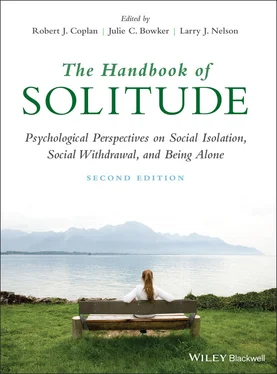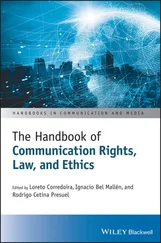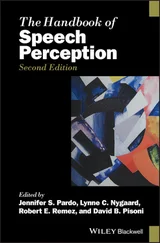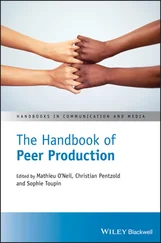1 Cover
2 Title Page
3 Copyright Page
4 Part I: Theoretical Perspectives 1 Alone Again: Revisiting Psychological Perspectives on Solitude Editors’ Note: Solitude in the Time of COVID‐19 Alone Again: Revisiting Psychological Perspectives on Solitude References 2 Evolutionary and Neuroscientific Perspectives on Adaptive Shyness Are There Adaptive Functions of Shyness? What Are Some of the Regulatory Mechanisms of Adaptive Shyness? How Are These Self‐Regulatory Mechanisms Instantiated in the Brain in Adaptive Shyness? Conclusion References 3 An Attachment Perspective on Solitude and Loneliness References 4 What Does Animal (Nonhuman) Research Tell Us About Social Deprivation and Social Isolation? What Does Animal (Nonhuman) Research Tell Us About Social Deprivation and Social Isolation? The Importance of Understanding the Effects of Social Deprivation and Social isolation Brief History of Theory and Research on the Role of Social Relationships for Development Nonhuman Primate Models Rodent Models Conclusion and Future Directions References 5 The Origins of Beneficial Solitude: Psychoanalytic Perspectives The Solitary Self The Capacity to Be Alone Companions in Solitude Conclusions References 6 Culture, Social Withdrawal, and Development Culture, Social Withdrawal, and Development References
5 Part II: Solitude Across the Life Span 7 Behavioral Inhibition and Psychopathology in Childhood Stability of Behavioral Inhibition Factors Contributing to Development and Maintenance of BI Conclusion and Future Directions References 8 Solitary Activities from Early Childhood to Adolescence: Causes, Content, and Consequences Nonsocial Play in Peer Contexts Solitary Activities Outside of School Conclusions and Future Directions: Considering Contexts References 9 Manifestations of Solitude in Interpersonal Contexts and Negative Peer Experiences: Manifestations of Solitude in Interpersonal Contexts and Negative Peer Experiences: Peer Rejection, Exclusion, and Victimization The Construct of Solitude and Identification of Solitary Subtypes The Concept of Negative Peer Experiences and Corresponding Relational Forms Solitude’s Relation to Negative Peer Experiences: Developmental Course and Directions of Effect References 10 Social Withdrawal During Adolescence: The Role of Peers Overview of Social Withdrawal Research Social Withdrawal and Peers During Adolescence Group‐Level Peer Experiences Dyadic‐Level Peer Experiences Future Research Directions 11 Social Withdrawal During Emerging Adulthood Conclusion References 12 Current and Future Paths in Research on Singlehood References 13 Social Isolation, Loneliness, and Solitude in Older Adulthood Introduction A Multifaceted View of Time Alone: Social Isolation, Loneliness, and Solitude Social Isolation, Loneliness, and Solitude in Adulthood: Links with Physical and Mental Health Solitude in Older Adulthood: Time Matters Solitude in Older Adulthood: Explanatory Mechanisms Moderators of Solitude‐Health Links Future Directions Conclusion Acknowledgments References
6 Part III: Understanding Solitude: Constructs, Processes, and Contexts 14 Social Approach and Avoidance Motivations Social Approach and Avoidance Motivations Approach and Avoidance as Two Fundamental Systems Social Approach and Avoidance Motivations and Related Constructs Historical Roots of the Research on Social Approach and Avoidance Motivations Establishing and Maintaining Social Relationships as a Function of Social Motivations Cognitive, Emotional, and Behavioral Processes of Social Approach and Avoidance Motivations The Origins and Development of Social Approach and Avoidance Motivation Across the Life Span Implications for Interventions Conclusions and Future Directions References 15 Ostracism and Solitude “I Want To Be Alone”: Self‐Ostracism/Being Alone. Summary References 16 The Possibilities of Aloneness and Solitude: Developing an Understanding Framed Through the Lens of Human Motivation and Needs Introduction Distinguishing Aloneness and Solitude Effects of Aloneness and Solitude The Role of Autonomy in Aloneness and Solitude Personality and Being Alone Authenticity in Solitude References 17 Getting Even Lonelier? Problematic Use of Media Loneliness as a Cause of Problematic Use of Media, and Mediating Factors Linking the Two Loneliness as an Outcome of Problematic Use of Media Vicious Bidirectional Cycle Between Loneliness and Problematic Use of Media Two Competing Theoretical Models to Explain the Bidirectional Cycle Buffers to Problematic Use of Media: Face‐to‐Face Interaction and Social Support Where Do We Go From Here? Conclusion References 18 New Media and Solitude: Implications for Peer Relations New Media and Solitude: Implications for Peer Relations Theoretical Overview Mobile Phone Use Social Networking Site Use Social Exclusion Cybervictimization Future Directions and Conclusions References 19 Alone Versus Together: Finding the Right Balance for Creativity References 20 Solitude as a Means to Obtaining Mental Rest in Skilled Athlete Populations Solitude as a Means to Obtaining Mental Rest in Skilled Athlete Populations Eccles and Kazmier’s (2019) Model of the Psychology of Rest in Athletes Conclusions References 21 From Shyness to Social Anxiety: Understanding Solitude in the Context of Immigration From Shyness to Social Anxiety: Understanding Solitude in the Context of Immigration References
7 Part IV: Solitude, Health, and Psychopathology 22 Introversion, Solitude, and Happiness Introversion, Solitude, and Happiness References 23 Solitary and Social Aspects of Restoration in Nature Restoration Studies Using Individuals and Small Groups as Participants Private Spaces in Childhood and Adolescence Restorative Experiences, Solitude, and Social Relationships in Natural Favorite Places The Social Context of Restoration Conclusions and Future Directions References 24 Intentional Solitude and Mindfulness Seeking Solitude Through Mindfulness and Meditation Positive Solitude/Mindfulness for Children and Adolescents Gaining Acceptance and Perspective in Positive Mindful Solitude in Adulthood Developing Positive Mindful Solitude Conclusion References 25 Loneliness and Associated Mental Health Sequelae in Individuals with Autism Spectrum Disorder Theoretical Basis of Loneliness Loneliness in ASD Understanding Loneliness in ASD The Experience of Loneliness in ASD Multiple Reporters on Friendships in ASD: What Do We Know and How Do We Know It? Summary Potential Negative Sequelae of Loneliness Protective Factors Against Loneliness Among Individuals with ASD Potential for Interventions Looking Forward: A Focus on Interventions for Adults with ASD Conclusion References 26 Social Anxiety Disorder and Emotional Solitude Social Anxiety Disorder and Emotional Solitude References 27 Hikikomori: Risks and Consequences of Extreme Self‐imposed Social Marginalization Introduction The Well‐Being of Young People Who Live in High‐Income Countries Hikikomori – Prolonged Socially Withdrawn Individuals Theoretical Understandings of Hikikomori The Three‐Process Framework of Hikikomori: Risks and Consequences Challenges and Future Directions Conclusion References 28 Solitary Confinement Is Not “Solitude”: The Adverse Effects of Social Isolation, Social Exclusion, and Loneliness Solitary Confinement Is a Form of “Toxic” Social Isolation The Specific Psychological Effects of Solitary Confinement Extreme and Prolonged Effects of Solitary Confinement Reducing and Eliminating the Use of Solitary Confinement Conclusion
8 Part V: Magnum Opus 29 Social Withdrawal in Childhood: A Personal History of Theory and Research That Guided a Program of Developmental Research Social Withdrawal in Childhood: A Personal History of Theory and Research That Guided a Program of Developmental Research Remembering Your Ancients Carmichael’s Manual of Child Psychology, Third Edition (1970) Beginnings The Waterloo Longitudinal Project (WLP) Parental Beliefs, Parenting, and Social Withdrawal: The Child in the Family Study The Waterloo Toddler Project Summary and Conclusions References
Читать дальше




![О Генри - Справочник Гименея [The Handbook of Hymen]](/books/407356/o-genri-spravochnik-gimeneya-the-handbook-of-hymen-thumb.webp)







